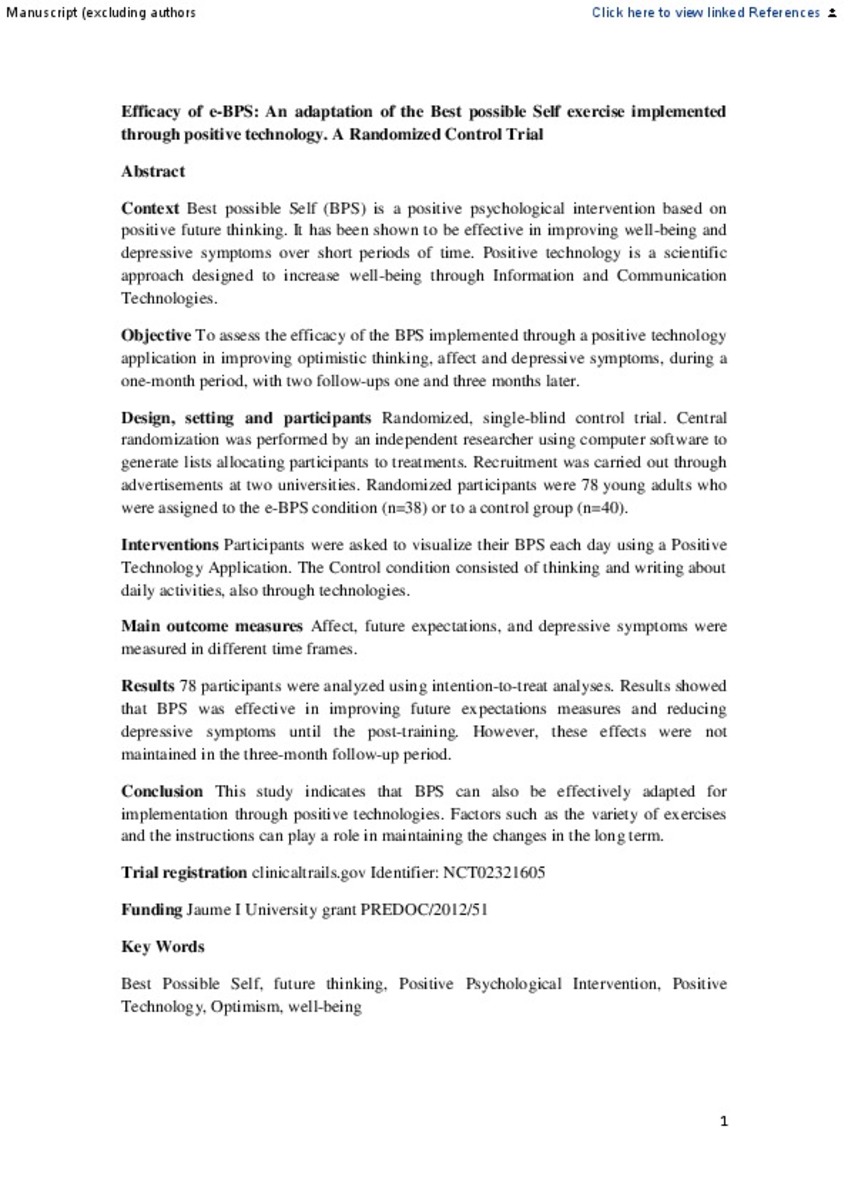Mostrar el registro sencillo del ítem
Efficacy of an adaptation of the Best Possible Self intervention implemented through positive technology: a randomized control trial
| dc.contributor.author | Enrique Roig, Angel | |
| dc.contributor.author | Bretón-López, Juana | |
| dc.contributor.author | Molinari, Guadalupe | |
| dc.contributor.author | Baños, Rosa Maria | |
| dc.contributor.author | Botella, Cristina | |
| dc.date.accessioned | 2018-03-13T12:16:40Z | |
| dc.date.available | 2018-03-13T12:16:40Z | |
| dc.date.issued | 2017 | |
| dc.identifier.citation | ENRIQUE, Ángel, et al. Efficacy of an adaptation of the Best Possible Self intervention implemented through positive technology: a randomized control trial. Applied Research in Quality of Life, 2017, p. 1-19. | ca_CA |
| dc.identifier.issn | 1871-2584 | |
| dc.identifier.issn | 1871-2576 | |
| dc.identifier.uri | http://hdl.handle.net/10234/173341 | |
| dc.description.abstract | Best possible Self (BPS) is a positive psychological intervention based on positive future thinking. It has been shown to be effective in improving well-being and depressive symptoms over short periods of time. Positive technology is a scientific approach designed to increase well-being through Information and Communication Technologies. To assess the efficacy of the BPS implemented through a positive technology application in improving optimistic thinking, affect and depressive symptoms, during a one-month period, with two follow-ups one and three months later. Randomized, single-blind control trial. Central randomization was performed by an independent researcher using computer software to generate lists allocating participants to treatments. Recruitment was carried out through advertisements at two universities. Randomized participants were 78 young adults who were assigned to the e-BPS condition (n = 38) or to a control group (n = 40). Participants were asked to visualize their BPS each day using a Positive Technology Application. The Control condition consisted of thinking and writing about daily activities, also through technologies. Affect, future expectations, and depressive symptoms were measured in different time frames. 78 participants were analyzed using intention-to-treat analyses. Results showed that BPS was effective in improving future expectations measures and reducing depressive symptoms until the post-training. However, these effects were not maintained in the three-month follow-up period. This study indicates that BPS can be effectively adapted for implementation through positive technologies. Factors such as the variety of exercises and the instructions can play a role in maintaining the changes in the long term. | ca_CA |
| dc.format.extent | 19 p. | ca_CA |
| dc.format.mimetype | application/pdf | ca_CA |
| dc.language.iso | eng | ca_CA |
| dc.publisher | Springer Verlag | ca_CA |
| dc.relation.isPartOf | Applied Research in Quality of Life, 2017 | ca_CA |
| dc.rights | © Springer International Publishing AG. This is a pre-print of an article published in Applied Research in Quality of Life. The final authenticated version is available online at: https://doi.org/10.1007/s11482-017-9552-5 | ca_CA |
| dc.rights.uri | http://rightsstatements.org/vocab/InC/1.0/ | * |
| dc.subject | best possible self | ca_CA |
| dc.subject | future thinking | ca_CA |
| dc.subject | positive psychological intervention | ca_CA |
| dc.subject | positive technology | ca_CA |
| dc.subject | optimism | ca_CA |
| dc.subject | well-being | ca_CA |
| dc.title | Efficacy of an adaptation of the Best Possible Self intervention implemented through positive technology: a randomized control trial | ca_CA |
| dc.type | info:eu-repo/semantics/article | ca_CA |
| dc.identifier.doi | https://doi.org/10.1007/s11482-017-9552-5 | |
| dc.relation.projectID | Jaume I University grant PREDOC/2012/51 | ca_CA |
| dc.rights.accessRights | info:eu-repo/semantics/openAccess | ca_CA |
| dc.relation.publisherVersion | https://link.springer.com/article/10.1007/s11482-017-9552-5 | ca_CA |
| dc.type.version | info:eu-repo/semantics/submittedVersion | ca_CA |
Ficheros en el ítem
Este ítem aparece en la(s) siguiente(s) colección(ones)
-
PSB_Articles [1301]
Articles de publicacions periòdiques







